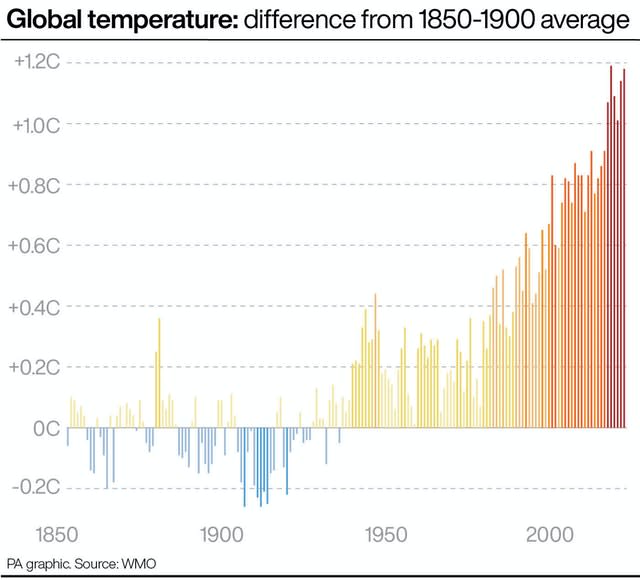2020 among the world’s hottest years as climate crisis continues
This year is set to be one of the hottest on record globally amid the ongoing climate crisis and extreme weather conditions, the World Meteorological Organisation (WMO) has said.
It has been “another extraordinary year” for the climate, with heatwaves, wildfires, hurricanes and floods compounding the threats to people’s lives, health and security created by the pandemic, the UN organisation warned.
The average global temperature in 2020 is set to be around 1.2C (34.2F) above the pre-industrial baseline of 1850-1900, provisional analysis for January to October shows.

That puts it on track to be one of the three hottest years on record, according to the assessment in the provisional report on the state of the global climate from the WMO.
This year is currently in second place in all five global datasets in the analysis, behind 2016 and ahead of 2019, though the difference between the years is small and could change once figures for the full year are in.
The hottest year on record, 2016, saw a strong El Nino event, a climatic pattern in the Pacific ocean which pushes up global temperatures on top of the impact of climate warming caused by humans.
But WMO secretary-general Professor Petteri Taalas said that while the world is currently experiencing a La Nina moment, which cools global temperatures, that has “not been sufficient to put a brake on this year’s heat”.
He added: “Despite the current La Nina conditions, this year has already shown near record heat comparable to the previous record of 2016.”

The past decade has been the hottest in temperature records stretching back to 1850, with the warmest six years on record all occurring since 2015.
There is a one in five chance that global average temperatures will temporarily exceed the threshold of 1.5C (34.7F) above pre-industrial levels by 2024.
Under the global Paris climate treaty, countries are committed to trying to curb global temperature rises to 1.5C (34.7F), a level beyond which the worst impacts of climate change will be felt.
The state of the climate report, which draws on information from national meteorological organisations, UN bodies and regional and global climate centres, detailed the effects already being seen.
Heat in the oceans is at record levels, with 80% of the world’s seas experiencing a marine heatwave at some time in 2020. This has hit wildlife and habitats already affected by increasing acidity as excess carbon dioxide dissolves into the water.

Ice continues to melt, sea levels are rising and extreme weather is creating floods, droughts and wildfires.
The Siberian Arctic was 5C (41F) hotter than normal this year, while heatwaves led to new temperature records in Australia, the Caribbean, and places in Israel and the Middle East.
Floods affected millions across the world, while drought hit South America and the US, where widespread dry conditions and extreme heat fuelled the largest fires ever recorded in the country in later summer and autumn.
There were double the average number of tropical cycles in the North Atlantic and 10 million people were forced from their homes by floods and storms in the first half of the year – mostly in South and South East Asia and the Horn of Africa.
Covid-19 complicated evacuations and relief efforts and the report estimates that more than 50 million people have been hit twice this year: by climate-related disasters such as floods and droughts, and by the pandemic.
It also highlights a warning from the International Monetary Fund that the global recession makes it challenging to enact the policies needed to cut the emissions that drive rising temperatures – but also presents opportunities to set the economy on a greener path.
Prof Taalas said: “We welcome all the recent commitments by governments to reduce greenhouse gas emissions because we are currently not on track and more efforts are needed.”

 Yahoo Movies
Yahoo Movies 
